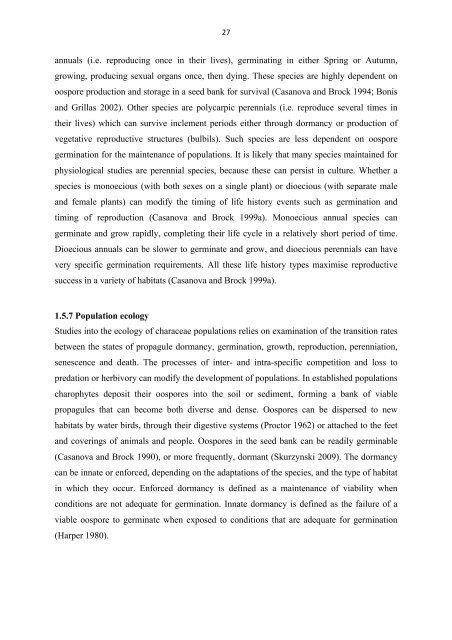Chapter 1: The Characeae Plant
Chapter 1: The Characeae Plant
Chapter 1: The Characeae Plant
Create successful ePaper yourself
Turn your PDF publications into a flip-book with our unique Google optimized e-Paper software.
27 <br />
annuals (i.e. reproducing once in their lives), germinating in either Spring or Autumn,<br />
growing, producing sexual organs once, then dying. <strong>The</strong>se species are highly dependent on<br />
oospore production and storage in a seed bank for survival (Casanova and Brock 1994; Bonis<br />
and Grillas 2002). Other species are polycarpic perennials (i.e. reproduce several times in<br />
their lives) which can survive inclement periods either through dormancy or production of<br />
vegetative reproductive structures (bulbils). Such species are less dependent on oospore<br />
germination for the maintenance of populations. It is likely that many species maintained for<br />
physiological studies are perennial species, because these can persist in culture. Whether a<br />
species is monoecious (with both sexes on a single plant) or dioecious (with separate male<br />
and female plants) can modify the timing of life history events such as germination and<br />
timing of reproduction (Casanova and Brock 1999a). Monoecious annual species can<br />
germinate and grow rapidly, completing their life cycle in a relatively short period of time.<br />
Dioecious annuals can be slower to germinate and grow, and dioecious perennials can have<br />
very specific germination requirements. All these life history types maximise reproductive<br />
success in a variety of habitats (Casanova and Brock 1999a).<br />
1.5.7 Population ecology<br />
Studies into the ecology of characeae populations relies on examination of the transition rates<br />
between the states of propagule dormancy, germination, growth, reproduction, perenniation,<br />
senescence and death. <strong>The</strong> processes of inter- and intra-specific competition and loss to<br />
predation or herbivory can modify the development of populations. In established populations<br />
charophytes deposit their oospores into the soil or sediment, forming a bank of viable<br />
propagules that can become both diverse and dense. Oospores can be dispersed to new<br />
habitats by water birds, through their digestive systems (Proctor 1962) or attached to the feet<br />
and coverings of animals and people. Oospores in the seed bank can be readily germinable<br />
(Casanova and Brock 1990), or more frequently, dormant (Skurzynski 2009). <strong>The</strong> dormancy<br />
can be innate or enforced, depending on the adaptations of the species, and the type of habitat<br />
in which they occur. Enforced dormancy is defined as a maintenance of viability when<br />
conditions are not adequate for germination. Innate dormancy is defined as the failure of a<br />
viable oospore to germinate when exposed to conditions that are adequate for germination<br />
(Harper 1980).
















